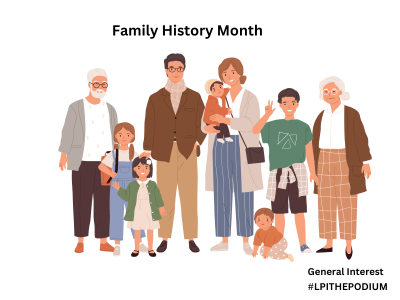
October has been designated “Family History Month.” Established by the United States Congress in 2001, the month is meant to encourage families to celebrate their heritage through research and education. Celebrating and preserving your family’s history can help you feel more connected to your past and the places your ancestors came from. It can also help you create stronger family relationships and make you more resilient in the face of challenges.
Here are some ways you can celebrate.
Connect with relatives.
Reach out to older relatives to learn about your family history. Oftentimes, the senior members of the family become historians and storytellers. They are the gatekeepers, so-to-speak, preserving the collective memories, names, places, important events, and milestones in the family.
Research your family.
Use documents, genealogy websites, libraries, city/county records, or DNA testing kits to learn more about your family. This can be super informative but can also be a journey down a long and tangled path without confirmed dates and places of birth/death, marriage dates, etc. While the U.S. Census records are usually a great resource for research, it is important to remember that the census often contains variations on vital statistics such as names and ages, and even complete misspellings of names. For example, my paternal family name is Crawford. The variations I have encountered on this name are: Crawfurd; Crawfirt; Crawfurt; Crawfoord; Crawfoot; Craufurd; Crayfurd; and more. My daughter’s paternal family name is Wickland, which I have seen spelled Wicklund, Vicklund, Vikland, etc. You can image that these names, especially if spoken with the accents of the country they are from (Scotland, Ireland, England, Norway, Sweden, etc.) could lead to all kinds of variants.
There can also be inconsistencies from one census to another when it comes to place of origin or birthplace, particularly for immigrants. America, for all its claims of welcoming the “poor, tired, hungry . . .” has not historically been kind to immigrants. There were many times in our history when, if you were an Irish, Italian, Polish, Asian, or other similar immigrant, it was not unheard of to see signs visibly posted saying, “Irish need not apply,” or “Spics not welcome.” Therefore, people would often lie to the census taker and state that they were from England rather than Ireland, or Spain rather than Italy. Ten years later, when the next census was being taken and the tide shifted regarding certain immigrant populations, the same person who said they were from England in 1920 may have felt comfortable in reporting their birthplace as Ireland in 1930.
Create a “zine.”
Make a personalized booklet, “e-zine,” or magazine on what you’ve learned about your family. You can include pictures, newspaper clippings, drawings, stickers, and other decorations. This is also a great place to include written translations of interviews with family members or stories that you have collected.
Write down and/or record your family history.
Record what you remember about your parents, grandparents, and other ancestors. As mentioned above, conduct interviews with family members who are willing to share their recollections and facts with you. Use a video recorder to physically capture those moments so that they are preserved in the person’s own words, with their own inflections, touches, and ways of telling the story.
Visit the places that are meaningful to you and/or your family.
It is fitting that Family History Month just happens to occur when I am on a 25-day ancestral pilgrimage through England and Scotland to explore my own family’s history and homeland. I used the family tree that I created on Ancestry.com, as well as the results of my Ancestry DNA, to pinpoint the areas where my ancestors were born, where they are buried, and the areas where historical records show they lived their lives and moved from one place to another. This gave me a great map for plotting out the places I wanted to visit on my journey.
Not everyone can take a trip across the world and make an ancestral pilgrimage. But you can make a “virtual pilgrimage” using the internet to see photos, watch videos, access documents and records, and learn as much as possible about the places and the people you are descended from.
Share your family history.
Present your research in an engaging way, such as with a family history book, scrapbook pages, or ancestor bookmarks. Make it a special occasion with a slideshow or video footage and share it at a family event. Print out and frame photos that have special significance and would mean the world to a loved one.
Final thoughts.
Not everyone has the benefit of a richly documented family history or a family historian who serves as the gatekeeper of memories. They may not know their birth family or where their family origins began. Perhaps it was something that was just never talked about or, as in my case, intentionally kept secret.
Regardless of your story, family is who you choose as well as where you come from. I hope you celebrate who you are and with those whom you call family.
Categorized in: General
| << previous | next >> |








